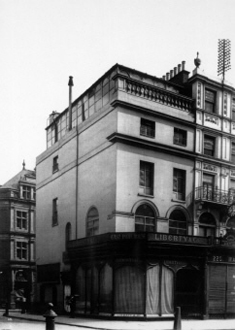Product Description
Archibald Knox / Liberty & Co. Square biscuit box with cover 1903-05


ARCHIBALD KNOX (1864-1933) UK
LIBERTY & CO. London
Square biscuit box w/cover 1903-05
Pewter with stylized blossom and leaf motif on each side
Marks: “Tudric” model no. 0237, MADE IN ENGLAND
Illustrated: Archibald Knox, ed. by Stephen A. Martin, London:Academy Editions, 1995, p. 83.
H: 5” x W: 4 3/8” square
Archibald Knox / Liberty & Co. Square biscuit box with cover 1903-05
SYDNEY PITCHER F.R.P.S. (d. 1950) England
ARTHUR H. PITCHER (Framer)
“St. Martin’s Cross Iona” c.1900
Carbon process photograph, hand carved oak frame with beautiful wood grain detail.
Marks: S MARTINS CROSS IONA (carved incised mark)
Art Nouveau paper label (on back): Framed by Arthur H. Pitcher, College Court, Gloucester, Moulding No…..
Photograph: H: 9 1/2″ x W: 5″
Frame: H: 16 3/4″ x W: 8 5/8″ D: 5/8″
Sydney A. Pitcher FRPS (active 1904-1939) was a photographer with an interest in monument and church architecture. He is listed in the 1927 Kelly’s Directory of the County of Gloucester as a commercial photographer, publisher and picture frame maker, operating from 5 & 7 College Court, Gloucester. Pitcher was involved primarily in the photography of Gloucestershire churches, but also took pictures of churches and cathedrals in neighbouring counties, and of medieval sculptures at Winchester College. He collaborated on the publication of Rushforth’s series of volumes The stained glass of Great Malvern Priory Church , Gloucester, 1916-1927.
He joined the Royal Photographic Society in 1904, was admitted as an Associate member in 1925, and became a Fellow in 1928.
Humberto Campana (1953 – ) Brazil
Fernando Campana (1961 – ) Brazil
Zig Zag Screen, 2001
Circular iron frame with electrostatic silver painted surface, translucent PVC hose stretched in a web pattern.
Illustrated: Campanas, Humberto and Fernando Campana (Sao Paulo: Bookmark 2003) p. 240; Mood River, February 3 – June 26, 2002, exh. cat. Jeffrey Kipnis and Annetta Massie (Ohio: Wexner Center, 2002)
H: 78” x D: 69”
Price: $11,500
